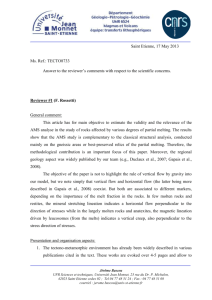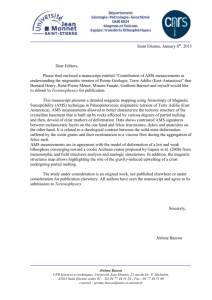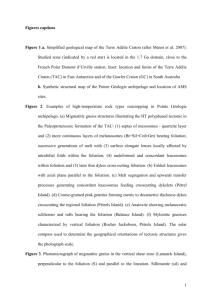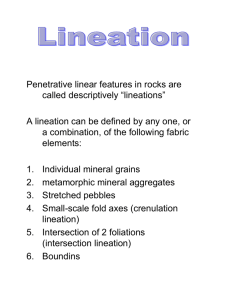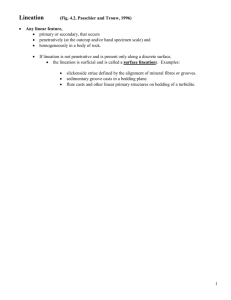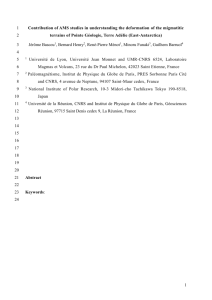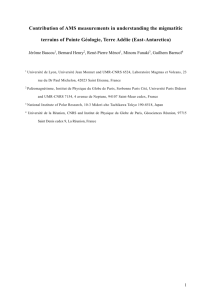Saint Etienne, 17 May 2013 Ms. Ref.: TECTO8733 "Contribution of
advertisement
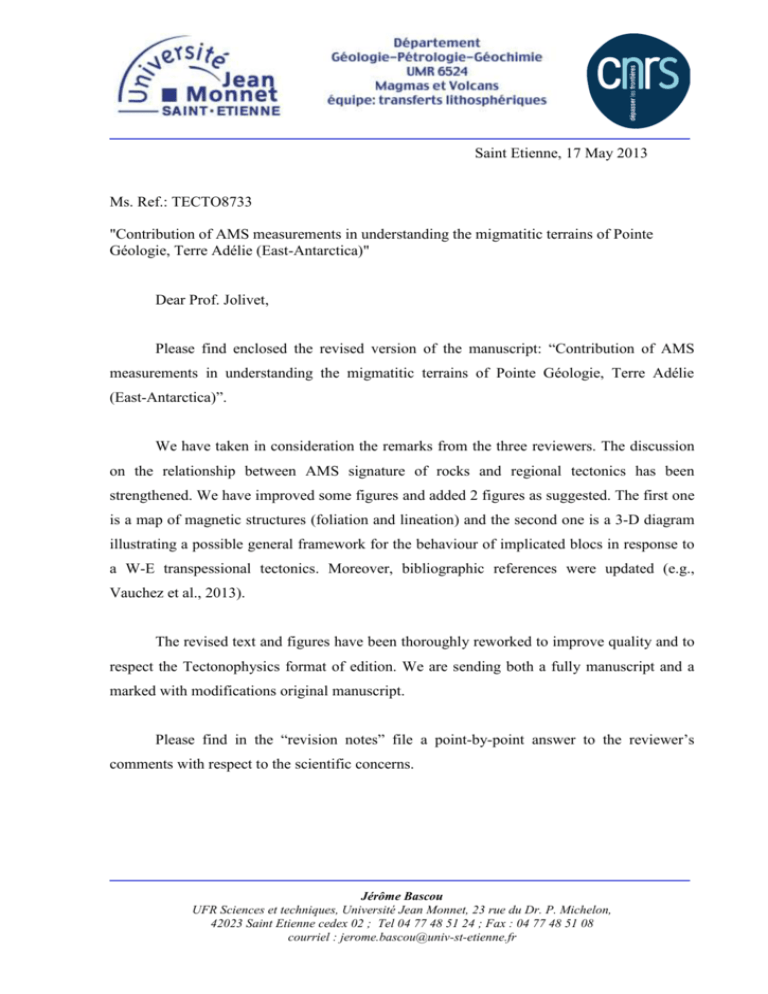
Saint Etienne, 17 May 2013 Ms. Ref.: TECTO8733 "Contribution of AMS measurements in understanding the migmatitic terrains of Pointe Géologie, Terre Adélie (East-Antarctica)" Dear Prof. Jolivet, Please find enclosed the revised version of the manuscript: “Contribution of AMS measurements in understanding the migmatitic terrains of Pointe Géologie, Terre Adélie (East-Antarctica)”. We have taken in consideration the remarks from the three reviewers. The discussion on the relationship between AMS signature of rocks and regional tectonics has been strengthened. We have improved some figures and added 2 figures as suggested. The first one is a map of magnetic structures (foliation and lineation) and the second one is a 3-D diagram illustrating a possible general framework for the behaviour of implicated blocs in response to a W-E transpessional tectonics. Moreover, bibliographic references were updated (e.g., Vauchez et al., 2013). The revised text and figures have been thoroughly reworked to improve quality and to respect the Tectonophysics format of edition. We are sending both a fully manuscript and a marked with modifications original manuscript. Please find in the “revision notes” file a point-by-point answer to the reviewer’s comments with respect to the scientific concerns. Jérôme Bascou UFR Sciences et techniques, Université Jean Monnet, 23 rue du Dr. P. Michelon, 42023 Saint Etienne cedex 02 ; Tel 04 77 48 51 24 ; Fax : 04 77 48 51 08 courriel : jerome.bascou@univ-st-etienne.fr Reviewer #1 (F. Rossetti) General comment: This article has for main objective to estimate the validity and the relevance of the AMS analyse in the study of rocks affected by various degrees of partial melting. The results show that the AMS study is complementary to the classical structural analysis, conducted mainly on the gneissic areas or best-preserved relics of the partial melting. Therefore, the methodological contribution is an important focus of this paper. Moreover, the regional geology aspect was widely published by our team (e.g., Duclaux et al., 2007; Gapais et al., 2008). The objective of the paper is not to highlight the rule of vertical flow by gravity into our model, but we note simply that vertical flow and horizontal flow (the latter being more described in Gapais et al., 2008) coexist. But both are associated to different markers, depending on the importance of the melt fraction in the rocks. In few molten rocks and restites, the mineral stretching lineation indicates a horizontal flow perpendicular to the direction of stresses while in the largely molten rocks and anatexites, the magnetic lineation driven by leucosomes (from the melts) indicates a vertical creep, also perpendicular to the stress direction of stresses. Presentation and organisation aspects: 1. The tectono-metamorphic environment has already been widely described in various publications cited in the text. These works are evoked over 4-5 pages and allow to introduce the problematic: Is-it possible to extract structural information from largely melted rocks? In Pointe Géologie, migmatites showing high degree of partial melting and anatexites outcrop over a large area (about 90% in volume). 2. We have reworked the caption of Figure 2 (photos of outcrops), in order to better clarified the relationships between the various high-temperature rock types. 3. As mentioned above, our objective is to test the efficiency of the AMS technique in migmatites. In addition, the rocks of the Dumont d'Urville archipelago have already been detailed in petrological and mineralogical works, which are a solid cited reference base (Monnier, 1995, Monnier et al, 1995; Peucat et al, 1999; Pelletier et al, 2005; Gapais et al, 2008). This is why we have focused mainly on the mineralogical analysis of magnetic carriers. 4. As suggested, we added a map of magnetic structures (foliation and lineation) resulting from AMS measurements (Figure 11 of the revised manuscript). Specific points: 1. The numbering of figures was corrected. 2. The text and figure captions were reworked. 3. Compared to previous works, we focus more specifically the space and time relationships between leucosomes and melanosomes in the migmatitic gneisses; it remains mentioned. 4. We have rephrased 5. We have rephrased 6. We have restructured as suggested 7. As also evocated in general remarks, the microscale fabrics and mineralogy of samples have been widely describes in several publications. We have added precisions (+ references) for ilmenite LPO measurements and their representation. Crystallographic lattice of magnetite remains randomly oriented in spite of a strong elongation of grains. For ilmenite, LPO could be measured only in the melanosomes. In more melted area, the small number of grains prevents results based on robust statistic approach. 8. Photomicrograph of Figure 2 is normal to foliation (S) and parallel to lineation. It was added in figure caption. 9. Magnetite presents large grain size; it was rephrased. 10. We have rephrased. 11. Idem 7. 12. Comparison between AMS measurements, field observations and thin section analyse in both melanosomes and leucosomes (of the same site) support our conclusions. 13. “pg 19, lines 34-36” in this part of the discussion, we indicate, in the revised version, that the K1 orientation, which tends to a vertical plunge during segregation and circulation of felsic melt pointing out a dominantly upward transport. Latter, in the discussion on regional-scale implication, we explain that melt segregation and transfer occur under a viscous flow regime, mainly driven by gravity forces. In addition, we clarified the links with tectonics. Rheological changes related Jérôme Bascou UFR Sciences et techniques, Université Jean Monnet, 23 rue du Dr. P. Michelon, 42023 Saint Etienne cedex 02 ; Tel 04 77 48 51 24 ; Fax : 04 77 48 51 08 courriel : jerome.bascou@univ-st-etienne.fr to partial melting generate strain partitioning between gneisses and strongly melted rocks in a regional transpressional tectonics context. 14. In this paper we focussed on the ductile history of this particularly hot mid-crustal section. To avoid confusion with low-temperature history, we removed the sentence and references that could be interpreted as associated to a late implementation (brittle deformation) of dikes. 15. and 16. Field-based meso-structural word and systematic petrographical study are widely documented in previous publications Figures: 1. As suggested, we added a figure displaying synthetic representation of the AMS fabric (magnetic foliation and lineation). 2. Photographs presented in Figure 2 allow us to show details of various spatial-temporal relationships between melt and gneissic rocks. We have improved caption of the Figure 2. Reviewer #2 (F. Storti) General comment: As indicated previously, two figures have been added to facilitate the visualization of the AMS data. Figures are in Arabic numbers in the revised manuscript. Specific points: 1. Sentence rewritten 2. “markers” deleted 3. “long-lived” instead of “long live”. Corrected 4. Sentences were rephrased 5. the verb was indeed missing. Corrected 6. “transpression” instead of “transpressionnal”. Corrected 7. This sentence and references have been removed (see above (reviewer #1) point n°14) 8. Sentence rewritten Reviewer #3 (D. Gapais) General remarks: - In migmatites, AMS signature appears as dependent from the partial melting degree. For low to moderate partial melting degree, the orientation of main susceptibility axes (K1, K2 and K3) in melanosomes and leucosomes is relatively similar. It shows that the liquid segregation remained strongly constrained by the framework of the unmelted gneissic material. For higher degree of melting (and for large volume of melt), K1 direction changes. It interpreted as resulting of melt segregation and transfer occurring under a viscous flow regime, mainly driven by gravity. Such mechanism associated to diapiric ascent of partially-molten crust has been already invocated to explain gneiss dome formation (e.g., Fayon et al., GSA Special papers, 2004). - As suggested, we added maps (in figure 1) showing the two main regional structures (vertical shear zones and flat-lying structures) and the samples location. - Relationships between flat-lying and verticals fabrics were clarified: frequently, vertical structures seem to be later than flat-lying ones but flat-lying structures reworking vertical ones have also been observed. Moreover, all these structures were developed under similar P-T and syn-anatectic conditions and then may be considered as nearly coeval (Monnier, 1995; Pelletier et al, 2002). - A sentence about the method used for fabric measurements was added. - As suggested, we moved the section on the P and T parameters definition in the analytical procedure section. - Subtitles (6.1.1. Structures in sub-vertical domains ; 6.1.2. Structures in domes-shaped zones) were added. - R2 is the coefficient of determination. It is the statistical measure of how well the regression line approximates the real data points (Figure 5). An R2 of 1 indicates that the regression line perfectly fits the data. - Deleted - As suggested: “mid-crustal conditions” instead of “deep-seated crustal conditions”. - We cut section 7.3 in two parts, as suggested. - The conclusion has been revised. - As suggested, the different symbols were put into the figures 5 and 11 (now12). Jérôme Bascou UFR Sciences et techniques, Université Jean Monnet, 23 rue du Dr. P. Michelon, 42023 Saint Etienne cedex 02 ; Tel 04 77 48 51 24 ; Fax : 04 77 48 51 08 courriel : jerome.bascou@univ-st-etienne.fr Specific comments: Specific comments mainly concern the English of the manuscript. We took into account the suggestions and comments, which allowed to improve the manuscript. Federico Rossetti, Fabrizio Storti and Denis Gapais are warmly thanked for their helpful suggestions. Sincerely yours, J. Bascou
